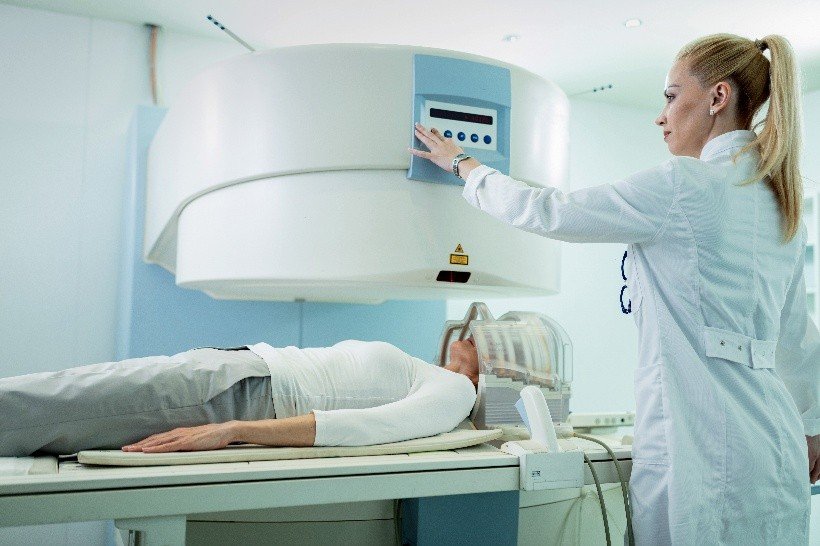Frances Ann Yap, MD

We present a case of a 40-year-old female from Pangasinan who presents at the clinic with complaints of persistent right hip pain. She had multiple consults with Orthopedic and Rehabilitation Medicine, all of whom recommended physical therapy which resolves pain temporarily. The pain had been recurrent and gradually worsening over the course of several months, limiting her mobility and affecting her daily activities. She denied any history of trauma, recent infection, or fever. Further inquiry revealed that the discomfort was associated with a palpable, slowly enlarging mass in the gluteal region.
Due to the progressive enlargement of the right gluteal mass and worsening pain, she underwent a core biopsy of the sacrococcygeal lesion. Histopathological analysis revealed a small round cell neoplasm, raising suspicion for metastatic disease. Immunohistochemical studies were consistent with a thyroid origin, prompting further evaluation of the thyroid gland.
Her past medical history was notable for a diagnosis of nodular nontoxic goiter in 2019. Neck ultrasonography revealed a 1.76 x 1.17 x 1.23 cm hypoechoic nodule in the right thyroid lobe, categorized as TI-RADS 4. At that time, a fine-needle aspiration biopsy (FNAB) of the thyroid nodule was performed, yielding a non-diagnostic result (Bethesda I). Unfortunately, the patient was lost to follow-up and did not undergo repeat evaluation or surveillance imaging.

On physical examination, the patient was stable and not in distress. Vital signs were within normal limits. Notably, a firm, non-tender anterior neck mass approximately 2 cm in size was palpable in the lower pole of the right thyroid lobe. There was no cervical lymphadenopathy. Examination of the right gluteal area revealed a non-erythematous, non-tender soft tissue mass measuring approximately 10 x 10 cm.
At this time, patient had difficulty ambulating and was unable to sit down due to size of the mass. She was referred back to orthopedic surgery for excision of the mass. Magnetic resonance imaging (MRI) of the pelvis showed a large, lobulated mass measuring 11 x 11.2 x 11 cm in the sacrococcygeal region. However, upon careful assessment, surgery was not recommended due to anticipated risks of the procedure. Because of the size of the mass and its significant impact on the patient’s quality of life, a multidisciplinary meeting was held wherein they weighed the treatment options for this patient.
Metastatic work-up was also done which showed the following: A chest CT scan revealed multiple, bilateral, subcentimeter non-calcified pulmonary nodules ranging from 2 mm to 7 mm, consistent with hematogenous metastases. An abdominal ultrasound revealed incidental findings including a simple hepatic cyst and intramural uterine myoma.
The patient was referred to otorhinolaryngology for surgical intervention and subsequently underwent a total thyroidectomy. Histopathological examination revealed a widely invasive follicular thyroid carcinoma of the oncocytic (Hurthle cell) variant, measuring 4.8 x 2.7 x 2.0 cm. The tumor exhibited angioinvasion, lymphatic and perineural invasion, positive margins, and extrathyroidal extension. One of four regional lymph nodes was positive for metastatic involvement. The final staging was T3N1M1, indicating advanced disease with distant metastasis.

Patient was then referred to radiation oncology for radiation therapy. She underwent RT which significantly decreased the size of the mass. Patient is now able to ambulate and can tolerate prolonged sitting. She was also given radioactive ablation iodine therapy 200 mCi. Post-therapy whole body scan showed RAI avidity in the left gluteal mass.
Currently, she is well and is undergoing surveillance every 6 months. As of now, there are no surgical plans for the gluteal mass. This case underscores the critical importance of vigilant follow-up, especially for thyroid nodules with inconclusive initial biopsies, as delayed diagnosis can lead to advanced metastatic disease. It highlights how atypical presentations, such as an enlarging gluteal mass, can be the initial manifestation of an underlying malignancy. The multidisciplinary approach, involving endocrinology, orthopedics, otorhinolaryngology, radiation oncology, and medical oncology, proved crucial in managing this complex case. Ultimately, this patient’s significant improvement in mobility and quality of life after radiation therapy and radioactive iodine ablation demonstrates the effectiveness of targeted treatments even in advanced metastatic thyroid carcinoma. This emphasizes the need for a high index of suspicion and comprehensive diagnostic workup when evaluating persistent, unexplained symptoms.



